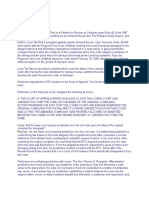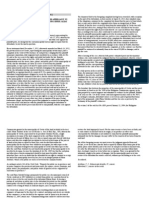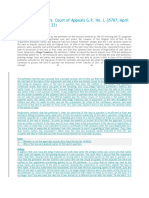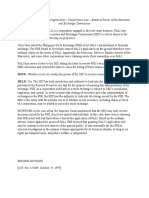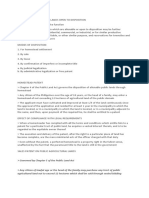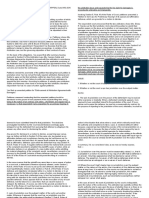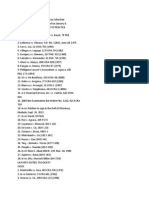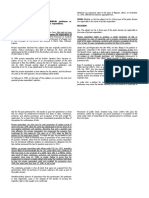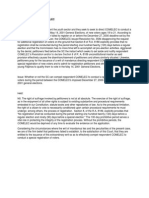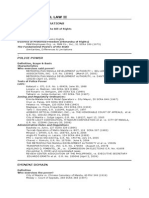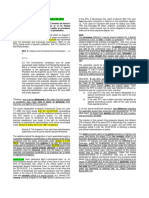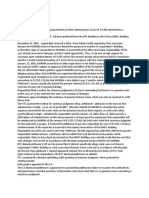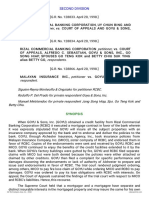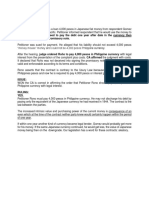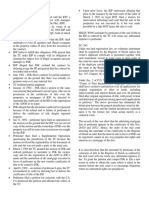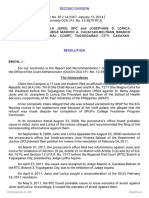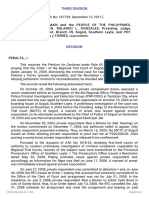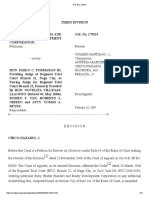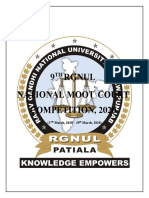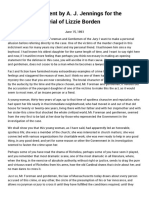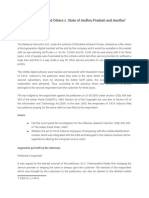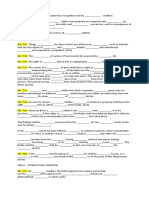303 Golden - Cane - Furniture - Manufacturing - Corp. - v.
303 Golden - Cane - Furniture - Manufacturing - Corp. - v.
Uploaded by
Carmille MagnoCopyright:
Available Formats
303 Golden - Cane - Furniture - Manufacturing - Corp. - v.
303 Golden - Cane - Furniture - Manufacturing - Corp. - v.
Uploaded by
Carmille MagnoOriginal Title
Copyright
Available Formats
Share this document
Did you find this document useful?
Is this content inappropriate?
Copyright:
Available Formats
303 Golden - Cane - Furniture - Manufacturing - Corp. - v.
303 Golden - Cane - Furniture - Manufacturing - Corp. - v.
Uploaded by
Carmille MagnoCopyright:
Available Formats
SECOND DIVISION
[G.R. No. 198222. April 4, 2016.]
GOLDEN CANE FURNITURE MANUFACTURING CORPORATION ,
petitioner, vs. STEELPRO PHILIPPINES, INC., SOCIAL SECURITY
SYSTEM, AIR LIQUIDE PHILIPPINES, INC., CLARK DEVELOPMENT
CORPORATION, PHILIPPINE NATIONAL BANK, BUREAU OF
INTERNAL REVENUE, UP-TOWN INDUSTRIES SALES, INC. ,
respondents.
DECISION
BRION , J : p
This is a petition for review on certiorari 1 led by Golden Cane Furniture
Manufacturing Corporation (Golden Cane) from the November 27, 2009 and August 16,
2011 resolutions of the Court of Appeals (CA) in CA-G.R. SP No. 111530 . 2 The CA
dismissed Golden Cane's petition for certiorari from the Regional Trial Court's (RTC)
May 11, 2009 3 and August 27, 2009 4 orders in Comm. Case No. 058 . 5
The CA dismissed the petition for certiorari for being the wrong remedy to
challenge the RTC's dismissal of Golden Cane's petition for corporate rehabilitation.
Antecedents
On November 3, 2008, Golden Cane led a Petition for Corporate Rehabilitation
with the RTC of San Fernando, Pampanga. The petition was raf ed to Branch 42 and
docketed as Comm. Case No. 058 . 6
On November 11, the RTC issued a Stay Order and set the initial hearing on
January 7, 2009. 7
On May 11, 2009, the RTC denied due course to the petition because of: (1) litis
pendentia and forum shopping due to the pendency of a separate Petition for
Suspension of Payments involving the same parties led by Golden Cane in 2007; (2)
the consistent failure of the rehabilitation receiver to ful ll her duties; (3) the receiver's
failure to le her bond on time; and (4) the receiver's failure to submit Golden Cane's
interim nancial statements. The RTC dismissed the petition and lifted the Stay Order. 8
On June 25, 2009, Golden Cane moved for reconsideration of the dismissal. 9
The RTC denied the motion for reconsideration on August 27, 2009. 10 Golden
Cane received a copy of the denial on October 2, 2009. 11
On November 23, 2009, Golden Cane elevated the case to the CA via a petition
for certiorari. The petition was docketed as CA-G.R. SP No. 111530 . 12
On November 27, 2009, the CA dismissed the petition outright for being the
wrong mode of appeal. 13 The CA held that the correct remedy is a petition for review
under Rule 43 of the Rules of Court pursuant to A.M. No. 04-9-07-SC . 14
Golden Cane moved to reconsider the dismissal but the CA denied the motion on
August 16, 2011. 15 Hence, on September 28, 2011, Golden Cane led the present
CD Technologies Asia, Inc. © 2016 cdasiaonline.com
petition for review on certiorari.
Golden Cane argues: (1) that A.M. No. 08-10-SC, or the 2008 Rules of Procedure
on Corporate Rehabilitation (the 2008 Rules) took effect on January 16, 2009, and
superseded A.M. No. 04-9-07-SC; (2) that under Rule 8 of the 2008 Rules, an order
denying due course to the petition for rehabilitation rendered before the approval or
disapproval of the rehabilitation plan is not appealable to the CA under Rule 43; (3) that
the remedy against such an order is a petition for certiorari under Rule 65 of the Rules
of Court.
The Issue
The lone issue is whether the correct remedy to challenge the outright dismissal
of Golden Cane's petition for rehabilitation is a petition for review under Rule 43 or a
petition for certiorari under Rule 65, both of the Rules of Court.
Our Ruling
We affirm the CA's ruling.
A corporate rehabilitation case is a special proceeding in rem wherein the
petitioner seeks to establish the status of a party or a particular fact, i.e., the inability of
the corporate debtor to pay its debts when they fall due. 16 It is summary and non-
adversarial in nature. 17 Its end goal is to secure the approval of a rehabilitation plan to
facilitate the successful recovery of the corporate debtor. 18 It does not seek relief
from an injury caused by another party. 19 AaCTcI
Jurisdiction over corporate rehabilitation cases originally fell within the
jurisdiction of the Securities and Exchange Commission (SEC) which had absolute
jurisdiction, control, and supervision over all Philippine corporations. 20 With the
enactment of the Securities Regulation Code in 2000, this jurisdiction was transferred
to the Regional Trial Courts. 21
Consequently, this Court enacted A.M. No. 00-8-10-SC or the Interim Rules of
Procedure on Corporate Rehabilitation (Interim Rules) which took effect on December
15, 2000. Under the Interim Rules, a motion for reconsideration was a prohibited
pleading. 22 Orders issued by the rehabilitation court were also immediately executory
unless restrained by the appellate court. 23
The Interim Rules, however, did not speci cally indicate the mode of appeal that
governed corporate rehabilitation cases. Thus, in 2004, the Court enacted A.M. No. 04-
9-07-SC to clarify the proper mode of appeal from decisions and nal orders of
Rehabilitation Courts:
Whereas, there is a need to clarify the proper mode of appeal in these cases in
order to prevent cluttering the dockets of the courts with appeals and/or
petitions for certiorari;
Wherefore, the Court Resolves:
1. All decisions and nal orders in cases falling under the Interim Rules
of Corporate Rehabilitation and the Interim Rules of Procedure Governing Intra-
Corporate Controversies under Republic Act No. 8799 shall be appealable to the
Court of Appeals through a petition for review under Rule 43 of the Rules of
Court. 24
In 2008, this Court enacted the Rules of Procedure on Corporate Rehabilitation 25
(2008 Rules). The 2008 Rules included motions for reconsideration as a relief from any
order of the court prior to the approval of the rehabilitation plan.
CD Technologies Asia, Inc. © 2016 cdasiaonline.com
RULE 8
PROCEDURAL REMEDIES
Section 1 . Motion for Reconsideration. — A party may le a motion for
reconsideration of any order issued by the court prior to the approval of the
rehabilitation plan. No relief can be extended to the party aggrieved by
the court's order on the motion through a special civil action for
certiorari under Rule 65 of the rules of Court . Such order can only be
elevated to the Court of Appeals as an assigned error in the petition for review of
the decision or order approving or disapproving the rehabilitation plan.
An order issued after the approval of the rehabilitation plan can be
reviewed only through a special civil action for certiorari under Rule 65 of the
Rules of Court.
Section 2 . Review of Decision or Order on Rehabilitation Plan. — An order
approving or disapproving a rehabilitation plan can only be reviewed
through a petition for review to the Court of Appeals under Rule 43 of
the Rules of Court within fteen (15) days from notice of the decision or
order. 26 [emphasis supplied]
Notably, the 2008 Rules also allowed a petition for certiorari under Rule 65 of the
Rules of Court as a recourse, but only against an order issued after the approval of the
rehabilitation plan. Lastly, the 2008 Rules adopted the mode of appeal prescribed in
A.M. No. 04-9-07-SC against an order approving or disapproving the rehabilitation plan.
In 2010, Congress enacted the Financial Rehabilitation and Insolvency Act (FRIA)
27which updated the existing laws on corporate rehabilitation. The Court promulgated
A.M. No. 12-12-11-SC, or the Financial Rehabilitation Rules of Procedure (2013 Rules)
on August 27, 2013. 28
The 2013 Rules adopted the same remedies as the 2008 Rules against
interlocutory orders of the rehabilitation court. However, the 2013 Rules eliminated the
remedy of appeal from the rehabilitation court's approval or disapproval of the
rehabilitation plan:
RULE 6
PROCEDURAL REMEDIES
Section 1 . Motion for Reconsideration. — A party may le a motion for
reconsideration of any order issued by the court prior to the approval of the
Rehabilitation Plan. No relief can be extended to the party aggrieved by
the court's order on the motion through a special civil action for
certiorari under Rule 65 of the Rules of Court .
An order issued after the approval of the Rehabilitation Plan can be reviewed
only through a special civil action for certiorari under Rule 65 of the Rules of
Court.
Section 2 . Review of Decision or Order on Rehabilitation Plan. — An order
approving or disapproving a rehabilitation plan can only be reviewed through a
petition for certiorari to the Court of Appeals under Rule 65 of the Rules of Court
within fifteen (15) days from notice of the decision or order. 29
Under the 2013 Rules, the Rehabilitation Court's nal order approving or
disapproving a rehabilitation plan is no longer subject to appeal; it can only be reviewed
through a petition for certiorari. The 2013 Rules narrowed the scope of appellate review
from errors of law and fact under Rule 43, 30 to errors of jurisdiction or abuse of
discretion under Rule 65. 31 It effectively lends more credence to the factual ndings
CD Technologies Asia, Inc. © 2016 cdasiaonline.com
and the judgment of rehabilitation courts.
Golden Cane's petition for
corporate rehabilitation falls under
the regime of the Interim Rules .
Golden Cane led its petition for rehabilitation on November 3, 2008 under the
regime of the Interim Rules. The initial hearing was also held on January 7, 2009, before
the effectivity of the 2008 Rules. 32 The transitory provision of the 2008 Rules states:
EcTCAD
Rule 9
Final Provisions
Sec. 2. Transitory Provision. — Unless the court orders otherwise to prevent
manifest injustice, any pending petition for rehabilitation that has not
undergone the initial hearing prescribed under the Interim Rules of Procedure for
Corporate Rehabilitation at the time of the effectivity of these Rules shall be
governed by these rules.
Accordingly, the Interim Rules — not the 2008 Rules — apply to Golden Cane's
petition for corporate rehabilitation.
The dismissal of the petition for rehabilitation, even if due to technical grounds or
due to its insuf ciency, amounts to a failure of rehabilitation. 33 It is a nal order
because it nally disposes of the case, leaving nothing else to be done. Pursuant to
A.M. No. 04-9-07-SC , the correct remedy against all decisions and nal orders of the
rehabilitation courts in proceedings governed by the Interim Rules is a petition for
review to the CA under Rule 43 of the Rules of Court. A petition for certiorari under Rule
65 of the Rules of Court is evidently the wrong mode of appeal.
Even if Golden Cane's petition were under the regime of the 2008 Rules, the
correct remedy would still have been a petition for review to the Court of Appeals under
Rule 43. 34 The outright dismissal of the petition can be seen as equivalent to the
disapproval of the rehabilitation plan. Ultimately, the result is the failure of
rehabilitation.
The result would have been different if Golden Cane's petition had been led
under the regime of the 2013 Rules. The 2013 Rules eliminated appeals from the
dismissal of the petition or the approval/disapproval of the rehabilitation plan and
specifically indicated certiorari as the correct remedy.
All things considered, we nd no reversible error in the resolution of the CA. It
correctly dismissed Golden Cane's petition for certiorari for being the wrong mode of
appeal.
WHEREFORE , we DENY the petition. Costs against the petitioner.
SO ORDERED .
Carpio, Del Castillo, Mendoza and Leonen, JJ., concur.
Footnotes
1. Rollo, p. 10.
2. Id. at 41, 44. Both penned by Associate Justice Ramon M. Bato, Jr. and concurred in by
Associate Justices Noel G. Tijam and Antonio L. Villamor.
3. Id. at 92.
CD Technologies Asia, Inc. © 2016 cdasiaonline.com
4. Id. at 146.
5. RTC, San Fernando City, Pampanga, Branch 42, through Judge Maria Amifaith S. Fider-
Reyes.
6. Rollo, p. 46.
7. Id. at 62.
8. Id. at 92.
9. Id. at 107.
10. Id. at 146.
11. Id. at 159.
12. Id. at 156.
13. Id. at 41.
14. Re: Mode of Appeal in Cases Formerly Cognizable by the Securities and Exchange
Commission, promulgated 14 September 2004.
15. Rollo, p. 44.
16. A.M. No. 00-8-10-SC, Re: Transfer of Cases from the Securities and Exchange
Commission to the Regional Trial Courts (September 4, 2001).
17. See Interim Rules, Rule 3, Section 1; 2008 Rules, Rule 3, Section 1; and A.M. No. 12-12-11-
SC, 2013 Financial Rehabilitation Rules of Procedure, Rule 1, Section 4, (August 27,
2013).
18. Supra note 16.
19. Id.
20. Presidential Decree No. 902-A, Sections 3 and 5 (b).
21. Republic Act No. 8799, Section 5.2.
22. Interim Rules, Rule 3, Section 1.
23. Interim Rules, Rule 3, Section 5:
Sec. 5. Executory Nature of Orders. — Any order issued by the court under these Rules is
immediately executory. A petition for review or an appeal therefrom shall not stay the
execution of the order unless restrained or enjoined by the appellate court. The review
of any order or decision of the court or an appeal therefrom shall be in accordance
with the Rules of Court: Provided, however, that reliefs ordered by the trial or appellate
courts shall take into account the need for resolution of proceedings in a just,
equitable, and speedy manner.
24. A.M. No. 04-9-07-SC (September 14, 2004).
25. A.M. No. 00-8-10-SC (December 2, 2008).
26. 2008 Rules, Rule 8, Secs. 1 and 2.
27. Republic Act No. 10142.
CD Technologies Asia, Inc. © 2016 cdasiaonline.com
28. A.M. No. 12-12-11-SC (August 27, 2013).
29. 2013 Rules, Rule 6, Section 1 and 2.
30. RULES OF COURT, Rule 43, Section 3.
31. RULES OF COURT, Rule 65, Section 1.
32. 2008 Rules, Rule 9, Section 3.
33. FRIA, Section 74.
34. 2008 Rules, Rule 8, Section 2.
CD Technologies Asia, Inc. © 2016 cdasiaonline.com
You might also like
- ANNEXURE D - Power of Attorney (Consortium Lead Bidder)Document3 pagesANNEXURE D - Power of Attorney (Consortium Lead Bidder)keshavNo ratings yet
- Alba Vs CA GR No. 164041 FactsDocument1 pageAlba Vs CA GR No. 164041 FactsCarmille MagnoNo ratings yet
- Judicial Affidavit Respondent FriendDocument3 pagesJudicial Affidavit Respondent FriendRoge Ante DublinNo ratings yet
- ScriptDocument3 pagesScriptIsse Nvrro100% (1)
- Code of Conduct: Golder Is Committed To High Standards of Ethical Behavior in The Conduct of Its BusinessDocument3 pagesCode of Conduct: Golder Is Committed To High Standards of Ethical Behavior in The Conduct of Its BusinessCésarAugustoGuevaraColmenaresNo ratings yet
- Process Flow Bids and Awards Committee For Public BiddingDocument2 pagesProcess Flow Bids and Awards Committee For Public BiddingLoyd Carlo IbarraNo ratings yet
- Study Material On CRPC LLB V PDFDocument79 pagesStudy Material On CRPC LLB V PDFChanchal Upadhyay100% (1)
- Florendo Vs Enrile, December 7, 1994Document4 pagesFlorendo Vs Enrile, December 7, 1994RenChaNo ratings yet
- Digest 1 Jurisdiction v. VenueDocument2 pagesDigest 1 Jurisdiction v. VenueMonica Bolado-AsuncionNo ratings yet
- Sps. Baysa vs. Sps PlantillaDocument13 pagesSps. Baysa vs. Sps PlantillaEunice NavarroNo ratings yet
- McLeod vs. National Labor Relations CommissionDocument43 pagesMcLeod vs. National Labor Relations CommissionXtine CampuPotNo ratings yet
- NatRe CasesDocument30 pagesNatRe CasesSittie Rainnie BaudNo ratings yet
- Cases On PropertyDocument40 pagesCases On PropertyLaike16No ratings yet
- Civil Pro - Digest - Batch 01 (1-4)Document4 pagesCivil Pro - Digest - Batch 01 (1-4)Boboy SevilleNo ratings yet
- G.R. No. 160239Document13 pagesG.R. No. 160239alain_kris0% (1)
- 1-Republic Vs CA 200 SCRA 226Document9 pages1-Republic Vs CA 200 SCRA 226enan_intonNo ratings yet
- Chavez Vs CA DigestedDocument4 pagesChavez Vs CA DigestedDave A ValcarcelNo ratings yet
- Admin Election LawDocument125 pagesAdmin Election LawJovenil BacatanNo ratings yet
- Case No. 16 Poblete Vs CADocument1 pageCase No. 16 Poblete Vs CAJoseph John Santos RonquilloNo ratings yet
- G.R. No. L-27343 - Singson VDocument18 pagesG.R. No. L-27343 - Singson Vabc defNo ratings yet
- Canon 8 Case CompilationDocument32 pagesCanon 8 Case Compilationchan.aNo ratings yet
- Adelfa S. Rivera v. Del Rosario G.R. No. 144934. January 15, 2004Document8 pagesAdelfa S. Rivera v. Del Rosario G.R. No. 144934. January 15, 2004denvergamlosenNo ratings yet
- Land Title New CasesDocument64 pagesLand Title New CasesCatherine Joy CataminNo ratings yet
- DIGEST Republic V SingunDocument16 pagesDIGEST Republic V SingunjapinxNo ratings yet
- Taxation 1 DigestsDocument133 pagesTaxation 1 DigestsAldrich AlmirezNo ratings yet
- PSE V CADocument15 pagesPSE V CAMp CasNo ratings yet
- Admin and Election Law GuideDocument17 pagesAdmin and Election Law GuideaceNo ratings yet
- Civ Pro CasesDocument15 pagesCiv Pro CasesNelsonPolinarLaurdenNo ratings yet
- PNB vs. QuimpoDocument3 pagesPNB vs. QuimpoDonvidachiye Liwag Cena100% (1)
- Impt Provs in NIRCDocument134 pagesImpt Provs in NIRCAziel Marie C. GuzmanNo ratings yet
- Engr. Feliciano v. COA, Et Al., G.R. No. 147402, Jan. 14, 2004Document15 pagesEngr. Feliciano v. COA, Et Al., G.R. No. 147402, Jan. 14, 2004Martin SNo ratings yet
- Civ Pro Finals S A Barre TransDocument23 pagesCiv Pro Finals S A Barre TransDennis Aran Tupaz AbrilNo ratings yet
- Poli CaseDocument86 pagesPoli Caseshi10No ratings yet
- Republic V Raneses - LTDDocument4 pagesRepublic V Raneses - LTDArJanNo ratings yet
- Governed by Chapter 5 of The Public Land ActDocument12 pagesGoverned by Chapter 5 of The Public Land ActIrang GandiaNo ratings yet
- La Naval Drug Corp Vs CADocument2 pagesLa Naval Drug Corp Vs CAUE LawNo ratings yet
- Negotiable Instrument Case Digest (MidTerms)Document28 pagesNegotiable Instrument Case Digest (MidTerms)brixphatesNo ratings yet
- TUCP Vs CosculluelaDocument4 pagesTUCP Vs CosculluelaAsHervea AbanteNo ratings yet
- Miguel v. Montanez Case DigestDocument1 pageMiguel v. Montanez Case DigestMykee NavalNo ratings yet
- Legal Ethics 1E and 1cattyDocument2 pagesLegal Ethics 1E and 1cattyJan Carlo Azada ChuaNo ratings yet
- Aklat Asosasyon Vs COMELECDocument11 pagesAklat Asosasyon Vs COMELECAsHervea AbanteNo ratings yet
- Tuazon Labor RevDocument78 pagesTuazon Labor RevianlaynoNo ratings yet
- Law On Sales and Lease: Cases On Pacto de Retro, Pre-Emption, Redemption, Assignment of Rights, and Lease (J. Gozun Notes)Document20 pagesLaw On Sales and Lease: Cases On Pacto de Retro, Pre-Emption, Redemption, Assignment of Rights, and Lease (J. Gozun Notes)Rob GozunNo ratings yet
- Ombudsman VsDelos ReyesDocument2 pagesOmbudsman VsDelos ReyesRaven Claire MalacaNo ratings yet
- Martinez v. RPDocument2 pagesMartinez v. RPNN DDLNo ratings yet
- Case Digests Arts 282-284Document83 pagesCase Digests Arts 282-284Farrah MalaNo ratings yet
- The Director LMB V CA 324scra757 DIGDocument2 pagesThe Director LMB V CA 324scra757 DIGAliNo ratings yet
- Case Digest For Palma Vs GalvezDocument3 pagesCase Digest For Palma Vs Galvezjonms0% (1)
- Santos vs. CADocument1 pageSantos vs. CAZniv SavsNo ratings yet
- G.R. No. 170912Document12 pagesG.R. No. 170912Rene Valentos100% (1)
- THOMAS BEGNAEN v. SPOUSES LEO CALIGTAN AND ELMACALIGTANDocument2 pagesTHOMAS BEGNAEN v. SPOUSES LEO CALIGTAN AND ELMACALIGTANearnswelltanNo ratings yet
- XXII. Partition - Casilang, Sr. Vs Casilang, Jr.Document2 pagesXXII. Partition - Casilang, Sr. Vs Casilang, Jr.SyElfredGNo ratings yet
- Election Law Case DigestsDocument25 pagesElection Law Case DigestsLean Manuel ParagasNo ratings yet
- Enriquez v. AbadiaDocument3 pagesEnriquez v. AbadiaCon PuNo ratings yet
- Roberto Otero Vs Roger TanDocument1 pageRoberto Otero Vs Roger TanArthur John GarratonNo ratings yet
- Lloyd's Enterprises Vs DolletonDocument2 pagesLloyd's Enterprises Vs Dolletonfroilan_bautistaNo ratings yet
- Constitutional Law 2 OutlineDocument15 pagesConstitutional Law 2 OutlineShane Ivy Antivo GarciaNo ratings yet
- Republic vs. Marcos (2012)Document3 pagesRepublic vs. Marcos (2012)Kristine MutiaNo ratings yet
- ALLIED BarDocument14 pagesALLIED BarFranz Raymond Javier AquinoNo ratings yet
- SANITATION CODE OF THE PHILIPPINES Chapter III of P.D 856Document94 pagesSANITATION CODE OF THE PHILIPPINES Chapter III of P.D 856Ariell EmraduraNo ratings yet
- Bordador Vs LuzDocument2 pagesBordador Vs LuzFrancis Coronel Jr.No ratings yet
- Heirs of Uberas Vs Cfi of Negros OccidentalDocument7 pagesHeirs of Uberas Vs Cfi of Negros OccidentalSamantha Bonilla BaricauaNo ratings yet
- Bla Bla Bla BlaDocument23 pagesBla Bla Bla BlaNeil AbayonNo ratings yet
- Cases Not Capable of Pecuniary EstimationDocument1 pageCases Not Capable of Pecuniary EstimationGrace Angelie C. Asio-SalihNo ratings yet
- General v. Special or Limited Jurisdiction (Gonzales v. GJH Land)Document1 pageGeneral v. Special or Limited Jurisdiction (Gonzales v. GJH Land)Daphne MarceloNo ratings yet
- 51 Golden Cane Furniture Manufacturing Corporation v. Steelpro Philippines, IncDocument2 pages51 Golden Cane Furniture Manufacturing Corporation v. Steelpro Philippines, IncRostum Agapito100% (1)
- Lexber Inc. vs. Dalman GR No. 183587Document9 pagesLexber Inc. vs. Dalman GR No. 183587Dailyn JaectinNo ratings yet
- MARINA VS MARC Properties DigestDocument3 pagesMARINA VS MARC Properties DigestCarmille MagnoNo ratings yet
- Borromeo Vs Family Care HospitalDocument2 pagesBorromeo Vs Family Care HospitalCarmille MagnoNo ratings yet
- Ty Kong Tin Vs RepublicDocument1 pageTy Kong Tin Vs RepublicCarmille MagnoNo ratings yet
- Asian Construction and Development Corporation VDocument2 pagesAsian Construction and Development Corporation VCarmille MagnoNo ratings yet
- Majestic Plus and GubatDocument12 pagesMajestic Plus and GubatCarmille MagnoNo ratings yet
- In Re Petition For Adoption of Michelle LimDocument2 pagesIn Re Petition For Adoption of Michelle LimCarmille MagnoNo ratings yet
- Francler Onde VS Office of The Local Civil Registrar of Las Pinas CityDocument2 pagesFrancler Onde VS Office of The Local Civil Registrar of Las Pinas CityCarmille MagnoNo ratings yet
- Complainants Respondent: Henrietta Piczon-Hermoso and Bezalel Piczon Hermoso, Atty. Sylvester C. ParadoDocument5 pagesComplainants Respondent: Henrietta Piczon-Hermoso and Bezalel Piczon Hermoso, Atty. Sylvester C. ParadoCarmille MagnoNo ratings yet
- Lahom Vs SibuloDocument1 pageLahom Vs SibuloCarmille MagnoNo ratings yet
- Petitioner vs. vs. Respondents Zosa & Quijano Law Offices: Second DivisionDocument9 pagesPetitioner vs. vs. Respondents Zosa & Quijano Law Offices: Second DivisionCarmille MagnoNo ratings yet
- Joycelyn Gualberto Vs Crisanto Gualberto GR. No. 154994 June 28, 2005 FactsDocument2 pagesJoycelyn Gualberto Vs Crisanto Gualberto GR. No. 154994 June 28, 2005 FactsCarmille MagnoNo ratings yet
- Alfon Vs RepublicDocument1 pageAlfon Vs RepublicCarmille MagnoNo ratings yet
- Ceniza Vs CADocument2 pagesCeniza Vs CACarmille MagnoNo ratings yet
- Complainant Respondent: Atty. Antonio B. Manzano, Atty. Carlos P. RiveraDocument7 pagesComplainant Respondent: Atty. Antonio B. Manzano, Atty. Carlos P. RiveraCarmille MagnoNo ratings yet
- CONFLICT Cases DigestsDocument3 pagesCONFLICT Cases DigestsCarmille MagnoNo ratings yet
- RCBC CaseDocument19 pagesRCBC CaseCarmille MagnoNo ratings yet
- ROÑO Vs GOMEZDocument1 pageROÑO Vs GOMEZCarmille MagnoNo ratings yet
- 16 Diego v. SandiganbayanDocument12 pages16 Diego v. SandiganbayanCarmille MagnoNo ratings yet
- Leticia Ligon Vs CADocument4 pagesLeticia Ligon Vs CACarmille MagnoNo ratings yet
- Beltran CaseDocument5 pagesBeltran CaseCarmille MagnoNo ratings yet
- Petitioners Vs Vs Respondents: Third DivisionDocument7 pagesPetitioners Vs Vs Respondents: Third DivisionCarmille MagnoNo ratings yet
- Paz To Gocheco Case DigestsDocument12 pagesPaz To Gocheco Case DigestsCarmille MagnoNo ratings yet
- Olbes Vs Judge BuemioDocument2 pagesOlbes Vs Judge BuemioCarmille MagnoNo ratings yet
- Activity in Expert WitnessDocument3 pagesActivity in Expert WitnessAngel Villamor CacheroNo ratings yet
- Curative Petition Vs ReviewDocument6 pagesCurative Petition Vs ReviewdownloadfromscribdNo ratings yet
- Juris Assignment 1Document4 pagesJuris Assignment 1mandlenkosiNo ratings yet
- A. Research On The Republic Act. 1425Document2 pagesA. Research On The Republic Act. 1425Kean Debert SaladagaNo ratings yet
- Ruby Shelter v. FormaranDocument19 pagesRuby Shelter v. FormaranHansel Jake B. PampiloNo ratings yet
- DSV Code of Conduct January 2022 - EnglishDocument15 pagesDSV Code of Conduct January 2022 - EnglishMuhamad Afri KurniawanNo ratings yet
- Affidavit of IncidentDocument2 pagesAffidavit of IncidentJanine AranasNo ratings yet
- 9th RGNUL Moot Court Competition 2020Document31 pages9th RGNUL Moot Court Competition 2020Prakash KumarNo ratings yet
- Opening Statement by A. J. Jennings For The Defense in The Trial of Lizzie BordenDocument4 pagesOpening Statement by A. J. Jennings For The Defense in The Trial of Lizzie BordenChoudhary Ali Aqdas100% (1)
- The Hindu Law of Inheritance Amendment Act 1929 PDFDocument3 pagesThe Hindu Law of Inheritance Amendment Act 1929 PDFMuhammad Sohail IsmailNo ratings yet
- Cyber Law IA 2Document3 pagesCyber Law IA 2Mehvash ChoudharyNo ratings yet
- Informal Trading FAQs PDFDocument12 pagesInformal Trading FAQs PDFcymNo ratings yet
- What Are The Different Forms of Strikes?Document3 pagesWhat Are The Different Forms of Strikes?Kaea AlvarezNo ratings yet
- Quiz 7Document5 pagesQuiz 7Vanessa Evans CruzNo ratings yet
- Guerrero ComplaintDocument13 pagesGuerrero ComplaintToast da MostNo ratings yet
- Part 1 Political Law Reviewer by Atty Sandoval PDFDocument161 pagesPart 1 Political Law Reviewer by Atty Sandoval PDFrosanie remotinNo ratings yet
- Discovery & Inspection, Order 11Document28 pagesDiscovery & Inspection, Order 11Aleena PlacidNo ratings yet
- Bibliography: Commemoration. Chicago: SalsedoDocument9 pagesBibliography: Commemoration. Chicago: Salsedoapi-119394251No ratings yet
- Historical Perspective of Securities LawsDocument31 pagesHistorical Perspective of Securities LawsShivam KumarNo ratings yet
- Eusebio-Calderon v. PeopleDocument10 pagesEusebio-Calderon v. PeopleMACASERO JACQUILOUNo ratings yet
- United Muslim and Christian Poor Association Vs Bryc-V Development CorporationDocument2 pagesUnited Muslim and Christian Poor Association Vs Bryc-V Development CorporationAl-Emir Yusoph BaltNo ratings yet
- Jesner V Arab Bank (138 S.CTDocument40 pagesJesner V Arab Bank (138 S.CTJean MazeaudNo ratings yet
- Court of Appeal For OntarioDocument35 pagesCourt of Appeal For Ontariorichard_warman0% (1)
- Carter-Ruck Newsletter Autumn/Winter 2013Document4 pagesCarter-Ruck Newsletter Autumn/Winter 2013Goku Missile CrisisNo ratings yet








